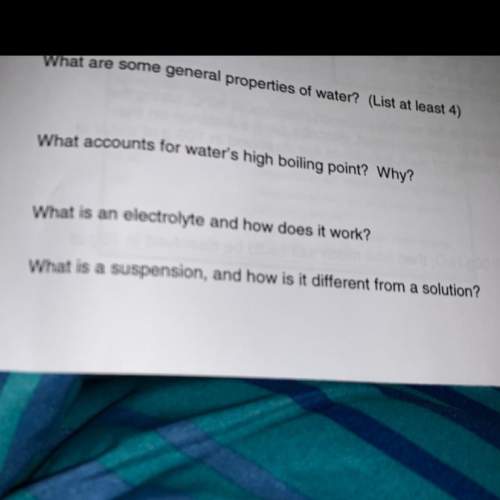
Chemistry, 13.11.2019 19:31 rosetoheart2
The reaction h2(g)+f2(g)? 2hf(g) is spontaneous at all temperatures. a classmate calculates the entropy change for this reaction and obtains a large negative value for ? s? .
part a
did your classmate make a mistake in the calculation?
did your classmate make a mistake in the calculation?
there is mistake in the calculation. the second law states that in any spontaneous process there is an increase in the entropy of the universe.
there is mistake in the calculation. the second law states that in any spontaneous process the increase in the entropy of the system equals zero. also there is a decrease in entropy of the system, as in the present case, this decrease is canceled by an increase in entropy of the surroundings.
there is no mistake in the calculation. the second law states that in any spontaneous process there is an decrease in the entropy of the system. also there is a decrease in entropy of the system, as in the present case.
there is no mistake in the calculation. the second law states that in any spontaneous process the decrease in the entropy of the system equals zero. also there might be a decrease in entropy of the system, as in the present case, this decrease is canceled by an increase in entropy of the surroundings.

Answers: 3
Another question on Chemistry

Chemistry, 22.06.2019 08:30
How would the number of moles (n) of o2 change if the atmospheric pressure doubled but all other variables stayed the same
Answers: 2

Chemistry, 22.06.2019 14:00
How many absorptions would you expect to observe in the 13c nmr spectra of the following molecules? a) 3-chloropentane b) cis-4-methyl-2-pentene
Answers: 2

Chemistry, 22.06.2019 15:50
How many moles of potassium hydroxide are needed to completely react with 2.94 moles of aluminum sulfate
Answers: 1

Chemistry, 22.06.2019 16:00
Is a measure of the resistance to flow. a high liquid has a high resistance to flow and flows slowly. the ancients thought everything in the world was made of 4 we now know that there are 94 naturally occurring and scientists have created another 24 i am certain they will create even more. honey flows slowly because it has a high to flowing. a can be separated by physical means because it contains more than one pure substance and 2 pure substances are not chemically bonded to each other. a cannot be separated by physical means. all matter is made up of all elements are with the same number of protons. if it is just a single or many bonded together, if all of them have the same number of protons, it is an element. in a piece of pure iron metal, all the are joined together, that piece of iron metal is called elemental iron. a single of iron is called elemental iron. a mixture has differences from place to place. we might need a microscope to see them or they might be obvious to the unaided eye. there are surfaces separating it into different phases. a mixture is the same everywhere. it is uniform. there are no surfaces separating it into different phases. if different kinds of atoms (different elements) are bonded together by their electrons, it is called a there are physical means of to isolate the different pure substances in a mixture and there are chemical means of to isolate the different elements in a compound. 1. element 2. compound 3. mixture 4. heterogeneous 5. homogeneous 6. pure substance 7. atoms 8. separation 9. viscosity 10. resistance
Answers: 2
You know the right answer?
The reaction h2(g)+f2(g)? 2hf(g) is spontaneous at all temperatures. a classmate calculates the entr...
Questions


History, 31.07.2019 04:30


Health, 31.07.2019 04:30

Social Studies, 31.07.2019 04:30




World Languages, 31.07.2019 04:30

Biology, 31.07.2019 04:30

Arts, 31.07.2019 04:30

English, 31.07.2019 04:30

Biology, 31.07.2019 04:30

History, 31.07.2019 04:30

Biology, 31.07.2019 04:30


English, 31.07.2019 04:30


History, 31.07.2019 04:30

Mathematics, 31.07.2019 04:30




